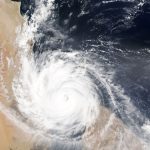 July 14, 2021 1:23 pm
Published by Climate Extremes
July 14, 2021 1:23 pm
Published by Climate Extremes
In this study, CLEX researchers and colleagues showed that the North Atlantic sea-surface temperature response to ENSO is nonlinear with respect to the strength of the sea-surface temperature forcing in the tropical Pacific.
 November 24, 2020 12:09 pm
Published by Climate Extremes
November 24, 2020 12:09 pm
Published by Climate Extremes
By grouping weather systems by similar patterns rather than averaging conditions over months, seasons or years, CLEX researchers found that between Australia and Antarctica, the ‘doughnut’ structure of SAM is split into multiple ‘flavours’ and is more likely to have ‘bite marks’ out of it than be a perfect ring.
 August 11, 2020 10:25 am
Published by Climate Extremes
August 11, 2020 10:25 am
Published by Climate Extremes
CLEX researchers and colleagues investigated how El Niños may change in the future using paleoclimate data in combination with CMIP5 and CMIP6 model runs.
 July 10, 2020 1:10 pm
Published by Climate Extremes
July 10, 2020 1:10 pm
Published by Climate Extremes
Ocean salinity could be an indicator of major rain events before IOD or ENSO events have peaked. This raises the prospect that long term forecasts for Australia could be improved by analysing sea surface salinity in the Indian and Pacific oceans.
 June 30, 2020 10:46 am
Published by Climate Extremes
June 30, 2020 10:46 am
Published by Climate Extremes
CLEX researchers found the influence of climate change and the depletion in stratospheric ozone are the major drivers over the Atlantic Oceans that shift westerly winds further south. However, over the Pacific and Indian oceans natural variations induced by sea surface temperature changes in the tropical Pacific also play an important role.
 June 9, 2020 3:34 pm
Published by Climate Extremes
June 9, 2020 3:34 pm
Published by Climate Extremes
CLEX researchers find the inclusion of upper South Pacific Ocean variability significantly improved the predictions of ENSO and PDO modes in simple linear inverse models.
 June 4, 2020 1:15 pm
Published by Climate Extremes
June 4, 2020 1:15 pm
Published by Climate Extremes
Marine heatwaves that impact southeast Australia could be forecast years in advance, with important implications for fisheries and the environment in this region
 April 15, 2020 10:26 am
Published by Climate Extremes
April 15, 2020 10:26 am
Published by Climate Extremes
This study presents a method for combining multiple observational datasets of the energy and water budgets at the land surface from different sources into a single hybrid dataset that conserves energy and mass.
 March 19, 2020 1:29 pm
Published by Climate Extremes
March 19, 2020 1:29 pm
Published by Climate Extremes
This two part paper examines the capacity of ACCESS to simulate tropical cyclone climatology and then used the same model to examine the relationship between climate variables and tropical cyclone formation.
 March 10, 2020 10:24 am
Published by Climate Extremes
March 10, 2020 10:24 am
Published by Climate Extremes
This study looks at the average climate in the northern hemisphere with a simplified climate model. It considers the atmospheric effects of mountain ranges (Tibet, Rockies), contrasts between land and ocean surface, and ocean currents at the surface (such as the Gulf Stream) and their impact on winter climate.










